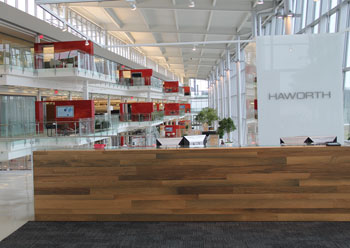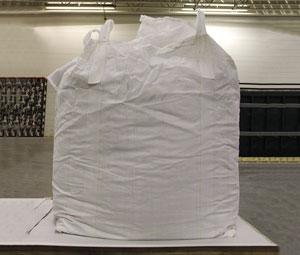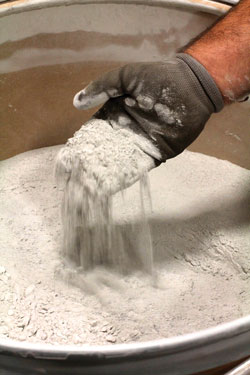Office Workspace-maker Finds Cradle-to-cradle Resolution for Powder Coat Waste
By Kate Bachman | January 21, 2013
Category:
Haworth Inc. is a designer and manufacturer of office furniture and workspaces with eight plants in the U.S. and several others around the world. All U.S. plants, as well as a plant in Pune, India, and one in Shanghai, achieved zero-landfill status by the second week of April 2009. The manufacturer’s global corporate headquarters in Holland, Mich., comprising a 1.5-million-sq.-ft. manufacturing facility and another 300,000 sq. ft. of corporate office space, is a Leadership in Energy and Environmental Design (LEED®) Gold-certified building, topped with a vegetative roof.
Recycling comes naturally to Haworth Inc., a global designer and manufacturer of office furniture and workspaces headquartered in Holland, Mich., with $1.38 billion annual sales in 2011, markets in more than 170 countries, and 6,000 employees globally.
Managing its waste well is part of the company’s sustainability vision statement that includes sustainable product and workspace design; increased energy efficiency and renewable energy utilization; green transportation; and green building design and practices (see Vision sidebar).
“When we built our first new building in 1980, we were recycling from day one—metals, cardboard, and so forth. And we were in the forefront with things like baling and recycling fabric,” said Bill Gurn, Haworth facilities maintenance manager (see Figure 1). “It was just good business sense.”
“Our founder, G.W. Haworth, would call me up and say, ‘What are you doing, Bill? Can you meet me down by the door to the plant?’ and I’d go down and there’d be a hunk of board in there. And he’d say, ‘Why are we throwing this away?’ And so our background was to understand what our waste streams were and to try to reduce those.
“But powder waste was going to the landfill. And that’s pretty much been the process for getting rid of waste powder for ages.”
Many things drive powder waste, and one is poor utilization, Gurn continued. The current industry average yield on powder ranges from 50 to 70 percent utilization, which means 50 to 30 percent is wasted, he said.
The situation is exacerbated by just-in-time manufacturing, because it necessitates continual color changes (see Figure 2). “When you’re in multiple-color manufacturing and you’re painting whites and blacks and beiges and charcoals and you’re
constantly doing changeovers, you’re ending up with a mix of colors, and sometimes even mixed properties.”
Recycling Center Improves Waste Management
Haworth established a fully operational, 19,000-sq.-ft. recycling center in January 1993 (see Figure 3).
“I think building the recycling center with a designated operational space set our tone as a true recycling company. Our challenge then was to try to find a home for as much stuff as we could.”
One of the ways that in-house processing enhances recycling efforts is that it allows the company to pull materials together from all over the U.S. and combine them to make larger quantities. “That helps us move those materials to brokers. That’s an issue with powder,” Gurn said.
The recyclables netted $1.4 million in revenue in 2011. “There’s no funny money in that. It’s profit,” Gurn said.
April 2009: Landfill-free

Figure 4
Waste powder coating is bagged and ready to ship. At the height of the recession, the company had nearly 2 million lbs. of waste powder in storage, waiting for a “home.”
The company set a landfill-free goal in August 2008 with the arrival of Kevin Bailey, then a new vice president. (He is now the vice president of global manufacturing.) “The first week he was here, he called me into his office. I no more than sat down and he asked, ‘When can we be landfill-free?’
“Two days later out comes the e-mail and he tells all the manufacturing facilities that their goal is to be landfill-free by first quarter. So the company had from August to April. Well, we made it by the second week of April 2009; we went landfill-free in the United States, China, and India,” Gurn said.
The company’s Portugal manufacturing sites in Queluz and Águeda achieved zero waste to landfill in 2012, completing Haworth’s zero-waste-to-landfill initiative in all three global Haworth sectors (North America and Asia Pacific, 2009; Europe, 2012).
Gurn found brokers who took the powder for free and paid the freight, so although he didn’t receive payment for it, he saved on the cost of dumping it in a landfill. “Anything you save under your landfill costs is making money.
“As you become more inclined to recycle and be landfill-free, you’ve got to find alternatives to landfill for the powder waste. And that’s where it really became troublesome,” Gurn said.
“Since we had a goal to go landfill-free by April 2009, I had to find a home for anything and everything. When you’re a large manufacturer with six plants that use powder coat and produce powder waste, it can become difficult.”
His dilemma became more challenging because the April 2009 deadline for achieving zero landfill fell closely on the heels of the 2008 market collapse and subsequent recession, Gurn said.
“And then the economy took its disastrous downslide in 2008 and the market just went totally away. You couldn’t give waste powder away. I went from giving it away to paying someone to take it.”
When the market dried up, Gurn started storing the powder that he couldn’t find an outlet for (see Figure 4). “I was actually paying to warehouse it. Over a two-year period, I had nearly 2 million pounds of powder in storage.”
That’s where the commitment to go landfill-free comes in, he said.
“Once you go landfill-free, you can never go back,” Gurn continued. “If you truly make that commitment, you can’t jump in and out of it. You can’t be landfill-free 364 days out of the year and then on the last day of the year, take all the stuff you can’t find a home for to dump in the landfill.”
Gurn said he began to search for new uses for the company’s powder waste. “We were beating the bushes trying to figure out where to go. And I was leaning on all the resources that I knew. We had feelers out anywhere and everywhere just to find a home for this growing stack of powder that became 2 million lbs. and plus.”
Cradle-to-Cradle Powder Coat Outlets

Figure 5
The powder coating has the consistency of talcum powder but is composed of a type of plastic resin. It can be repurposed not only as powder paint, but also as an adhesive or binder, an additive to cement and road aggregate, and even as a plastic product.
Gurn co-founded a powder coat waste user group as a result of participating in Western Michigan University’s Green Manufacturing Initiative (GMI). The group comprises several other manufacturers in western Michigan grappling with some of the same problems in dealing with their powder coat waste. (Read “Dispersing the powder coat waste problem on journey to zero landfill,” p. 22.)
He found brokers who shipped it for reuse as a mix for nonappearance parts. They blended a percentage of it with virgin raw black coating to make a dark gray to coat products that don’t require a specific color.
“There are places for it to go, but it gets real tricky. Some offshore manufacturers take a lot of recycled material to produce low-grade products, things that we don’t do in the States or that we don’t make money on.” He added a cautionary note.
“But you should be real careful. My concern for Haworth is that regardless of where it goes, whatever you do with it, it’s used properly. You don’t want it to end up in a teddy bear somewhere.
“I outsourced some powder to China through an importer/exporter. I demanded to know where it went and what it was being used for,” he said. “That’s an important piece, because to be globally and environmentally responsible, you have to know what your waste is being used for.
“So our directive to them was … I need to know where. And I also need to know for what. And I’d like to see the process. With today’s technology, we were able to verify where it was going to go, what it was going to be used for before we released it.”
The powder coat waste was being reused as powder paint on garden utensils for sale in discount stores. The manufacturers mixed it with black virgin powder and ended up with a slate gray to coat rakes and shovels, he said.
Today Haworth’s powder coat waste is not being used as paint at all, and it is used domestically.
“There are opportunities to use powder for uses other than as paint. The powder itself is a form of plastic, an epoxy [see Figure 5]. Just as when it is paint, it becomes a sort of flowing gel when heated and then it flows out and cools and hardens. You can actually use it as a bonding agent,” Gurn said.
Haworth’s powder coat waste is being used as a binder. It’s injected, melted, and mixed with fabric and then molded into another product as a binder and made into a backer or insulator material for use in the automotive and other industries.
All of the company’s powder waste is being consumed. “I send them two, three semitruck loads a month,” Gurn said.
Expanding Uses, Outlets
Gurn said there is still a lot more powder waste than there are cradle-to-cradle uses for it. “Powder waste still is a problem, and part of the problem is that there are not enough people who are making other products out of it.”
In addition to a binding agent, or being reblended, other uses are “in the wings,” he said, such as a concrete additive and converting it back into a liquid petroleum product. “They’re all byproducts of petroleum anyway. But none are commercially available,” he said.
Gurn said he believes part of the solution to finding outlets for waste powder coat lies in easing manufacturers’ expectations about color specs on some functional products. There is a tendency for offshore manufacturers to be less particular about color on products than domestic manufacturers are. That allows the manufacturer in the offshore country that makes those kinds of products to
utilize that waste powder material, Gurn said.
“None of us walks into a discount store and says, ‘Gee, honey, I think the black on this rake is blacker than it is on that rake.’ If we’re going in to buy a $12.99 rake, we don’t care exactly how black the black is on it.
“Maybe we have to find places where we’re not as fussy either.”
Next Step: Zero Waste
Gurn said the company’s corporate sustainability goal for waste runs deeper than zero landfill. “Our corporate sustainability goal is zero waste.”
The company set goals of 10 percent reductions in high-volume production waste from its manufacturing processes. Company engineers are working on them to see where less waste can be produced. “In the case of powder paint, it may be better equipment, better utilization of how we spray it,” Gurn said.
Zero waste and waste reductions have a real cost benefit, Gurn said. “The average cost of powder paint is about $2.88 per lb. So if you’re a big manufacturer, it’s not unusual to produce 100,000 lbs. of powder waste per month. So let’s say you have a 70 percent yield on powder. That means that you just wasted 30,000 lbs. at $2.88, that’s $86,400.
“So if you could improve your utilization by 10 percent, you just saved $28,800 a month. That’s $345,600 per year.
“So if we don’t produce any waste…
“Bottom line, zero waste is the right thing to do. It’s one of our sustainability goals. It’s where we need to go and what we need to do,” Gurn said.
“We have a responsibility. We don’t own this place, you know, Mother Earth. We’re just caretakers here.”
Photography courtesy of Lem Montero, Haworth, for Green Manufacturer.
Haworth Inc., One Haworth Center, Holland, MI 49423-9576, 616-393-3000, www.haworth.com
Vision Statement
Haworth will be a sustainable corporation. We engage our employees in more sustainable practices; we initiate and use processes that are neutral or improve our environment; and we utilize our resources in ways that create adaptable and sustainable workspace solutions for our customers. We do all of this globally to protect and restore our environment, create economic value, and support and
strengthen our communities.
Long-term Objectives
Haworth is committed to these seven sustainability objectives and has supporting short- and long-term objectives.
Sustainable Product and Workspace Design
Objective: Understand, reduce, and eliminate the negative environmental impacts from the manufacture, use, and end-of-life management of Haworth products and workspaces.
Energy Management
Objective: Increase energy efficiency and utilize renewable energy alternatives to become climate neutral, with the long-term objective of utilizing 100% renewable energy.
Green Transportation
Objective: Eliminate harmful emissions associated with the distribution of Haworth products and services and member business travel.
Zero Waste and Emissions
Objective: Eliminate waste and emissions associated with corporate operations and the production of products and services. This includes elimination of all greenhouse gases.
Green Building and Sustainable Site Management
Objective: Use green building design and practices to construct new buildings and interior renovations for all Haworth facilities worldwide and ensure sites in use are managed for sustainability.
Social Responsibility
Objective: Support the communities in which we conduct business and operate as an ethical organization.
Stakeholder Engagement
Objective: Engage all Haworth stakeholders in our path toward sustainability.

Side by side, we move metal fabrication forward.
FMA unites thousands of metal fabrication and manufacturing professionals around a common purpose: to shape the future of our industry, and in turn shape the world.
Learn More About FMA


